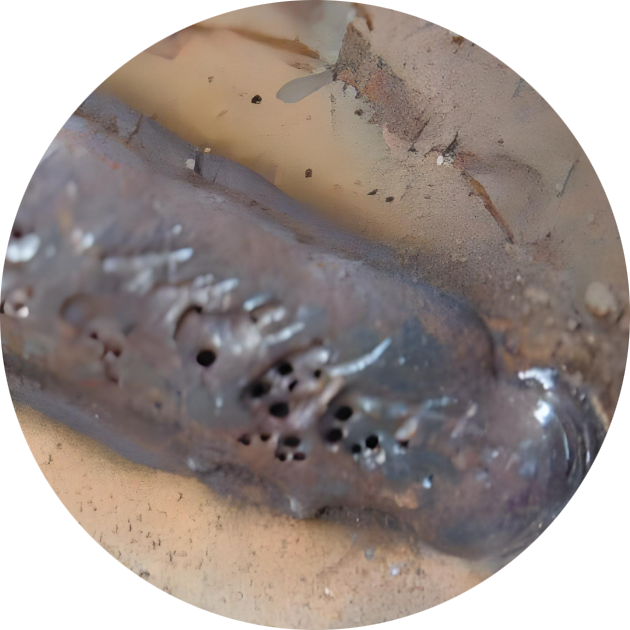Time to read: 6 min

Understanding Welding Defects
Welding defects are irregularities and imperfections that occur during the welding process, potentially weakening the weld joint or even leading to complete product failure. These defects can be broadly categorized into external and internal, each with distinct characteristics and detection methods.
External Welding Defects
External defects are visual and manifest on the surface of the weldment. They are detectable through visual inspection or non-destructive testing methods such as Magnetic Particle Inspection (MPI) or Dye Liquid Penetrants (DPI). Common external defects include cracks, undercuts, overlaps, porosity, and spatter.
Internal Welding Defects
Internal defects occur within the metal material and are not visible to the naked eye. Detecting these defects requires more advanced methods like Ultrasonic Testing and Radiographic Testing (RT). Examples of internal defects include slag inclusions, incomplete penetration, and incomplete fusion.
Common Types of Weld Defects and Their Remedies
-
Weld Cracks: Unwanted defects caused by stress and cooling, with types including longitudinal, transverse, crater, radiating, and branching. Remedies involve using suitable materials, proper welding speed and current, preheating, and reducing sulfur and carbon content.
-
Craters: Special types of cracks that occur due to improper crater filling. Remedies include ensuring proper filling and using the correct torch angle and welding technique.
-
Undercut: Irregular grooves formed on the base metal. Remedies involve reducing travel speed, lowering arc voltage, and using the proper gas mixture.
-
Porosity: Entrapment of air or gas bubbles in the weld. Remedies include choosing suitable electrodes, cleaning the base metal, and adjusting welding speed and gas flow.
-
Spatter: Metal particles expelled from the welding arc. Remedies involve adjusting weld current, using proper shield gas, and cleaning the metal surface.
-
Overlap: Excessive weld pool flow beyond the toe. Remedies include choosing the proper welding technique and maintaining the right electrode angle.
-
Lamellar Tearing: Cracks with a terraced appearance in rolled steel plates. Remedies include selecting high-quality materials and proper welding orientation.
-
Slag Inclusion: Trapped impurities from flux during welding. Remedies involve adjusting electrode angle, increasing current density, and preventing rapid cooling.
-
Incomplete Fusion: Unfilled gaps due to inaccurate welding. Remedies include using proper heat input, cleaning the welding area, and optimizing travel speed.
-
Incomplete Penetration: Insufficient weld metal spread through the joint. Remedies include correct joint alignment, proper amperage setting, and accurate electrode positioning.
-
Distortion: Changes in metal plate position and dimensions due to heat. Remedies include maintaining appropriate temperature gradients and welding orders.
-
Burn Through: Holes blown through the metal due to excessive heat. Remedies include avoiding high currents, excessive gaps, and slow torch movement.
-
Mechanical Damage: Indentations from incorrect welding techniques. Remedies include proper handling of welding tools and engaging the arc before welding.
-
Excess Reinforcement: Too much filler material in the weld joint. Remedies include maintaining proper torch speed and amperage and adjusting voltage.
-
Whiskers: Short electrode wires sticking out of the weld. Remedies include reducing electrode wire feed speed and travel speed.
-
Misalignment: Difference in heights between weld metal and base metal. Remedies include steady welding processes, skilled expertise, and proper welding wire placement.
Detecting Invisible Welding Defects
Non-destructive testing (NDT) is essential for detecting internal defects not visible to the naked eye. Methods such as Magnetic Particle Inspection, Ultrasonic Inspection, and Radiographic Inspection provide insights into the weld's integrity without damaging the material.
Distinguishing Between Weld Discontinuity and Weld Defects
Weld discontinuities are interruptions in the weldment's structure that may not affect the weld's functionality, while defects are more severe and require repair or rejection. Understanding the differences is crucial for maintaining quality standards.
Conclusion
Welding is a nuanced skill that demands precise execution and careful selection of techniques. Defects can compromise product quality and business performance. By understanding the types of welding defects, their causes, and prevention methods, manufacturers can uphold high standards in their welding processes.
Unofactory offers reliable sheet metal welding services with a commitment to quality and precision. Our skilled engineering team and professional technicians ensure the right choice of materials and techniques for your specific requirements. Contact us to discuss your project needs and get started on creating high-quality welded parts.




